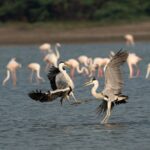Tree Kangaroos: Unique Marsupials of the Canopy
Tree kangaroos are fascinating marsupials native to the rainforests of Papua New Guinea, Indonesia, and some parts of Australia. Unlike their land-dwelling relatives, tree kangaroos have adapted to life in the trees, making them unique among kangaroos.
Physical Characteristics
Tree kangaroos are well-adapted for arboreal living. They possess strong, muscular forelimbs and shorter, broader feet compared to ground kangaroos. These adaptations help them grasp branches and climb with agility. Their long, bushy tails provide balance when navigating through the treetops.
Their fur is thick and plush, providing insulation against the cool temperatures often found in their high-altitude rainforest habitats. Fur coloration varies by species, ranging from reddish-brown to a near-black hue, often with lighter-colored bellies and markings.
Diet and Feeding Habits
Tree kangaroos primarily feed on leaves, fruits, and flowers. They are known to descend to the ground occasionally to feed on fungi and other available plant material. This omnivorous diet requires a strong digestive system capable of breaking down tough, fibrous leaves.
They exhibit some foraging behavior similar to that of their ground-dwelling relatives, such as storing food in cheek pouches and chewing cud. These behaviors enable them to maximize nutrient extraction from their less nutrient-dense diet.
Reproduction and Life Cycle
Tree kangaroos’ reproductive cycles are comparable to other marsupials. Females give birth to underdeveloped young, which crawl into the mother’s pouch to continue developing. The joey typically remains in the pouch for about 8 months before emerging.
Once out of the pouch, the young tree kangaroo remains dependent on the mother, gradually weaning over several months. Maturity is reached at around 2 years of age, varying slightly between species.
Behavior and Social Structure
Tree kangaroos are generally solitary animals, with each individual maintaining a territory marked by scent glands. Encounters between individuals are infrequent outside of mating seasons. However, some species may exhibit more social behavior, particularly in captivity or fragmented habitats.
They are mostly nocturnal, taking advantage of the cover of darkness to forage and move between trees. This nocturnal lifestyle helps them avoid some predators and reduce competition for food resources.
Species Diversity
There are approximately 14 recognized species of tree kangaroos, each with unique adaptations to their specific environments. Some of the well-known species include:
- Goodfellow’s Tree Kangaroo (Dendrolagus goodfellowi)
- Grizzled Tree Kangaroo (Dendrolagus inustus)
- Bennett’s Tree Kangaroo (Dendrolagus bennettianus)
- Lumholtz’s Tree Kangaroo (Dendrolagus lumholtzi)
Each species varies in size, coloration, and habitat preference, illustrating the diverse ecological niches they occupy.
Threats and Conservation
Tree kangaroos face numerous threats in the wild. Habitat destruction due to logging, agriculture, and human settlement poses the most significant risk. Deforestation leads to habitat fragmentation, which isolates populations and reduces genetic diversity.
Hunting for meat and traditional practices also impacts some species. Conservation efforts focus on habitat preservation, legal protection, and community-based conservation programs. Breeding programs in zoological facilities also contribute to maintaining genetic diversity and raising awareness about these unique marsupials.
Tree Kangaroo Research and Observations
Research on tree kangaroos is vital for conservation. Field studies help understand their behavior, ecology, and population dynamics. Observational studies in captivity provide insights into their dietary needs and reproductive behavior.
Advances in tracking technology allow researchers to monitor tree kangaroos’ movements and habitat use. This data informs conservation strategies and helps identify critical areas for protection.
Human Interactions and Cultural Significance
In some indigenous cultures, tree kangaroos hold cultural and spiritual significance. They appear in traditional stories, art, and ceremonial practices. Understanding these cultural connections is important for holistic conservation approaches that respect local traditions and knowledge.
Ecotourism centered around tree kangaroos provides economic benefits to local communities while promoting conservation. Sustainable tourism practices ensure that wildlife and habitats are protected for future generations.
Interesting Facts
- Tree kangaroos can leap up to 30 feet from one tree to another.
- Unlike ground kangaroos, tree kangaroos have lost some of their hopping efficiency but gained climbing prowess instead.
- Tree kangaroos’ closest relatives are the ground-dwelling wallabies and kangaroos of Australia.
The tree kangaroo’s ability to adapt to an arboreal lifestyle makes it a remarkable example of evolutionary specialization. Efforts to conserve these unique animals continue to grow, ensuring their presence in our world for generations to come.
“`




Subscribe for Updates
Get the latest articles delivered to your inbox.
We respect your privacy. Unsubscribe anytime.